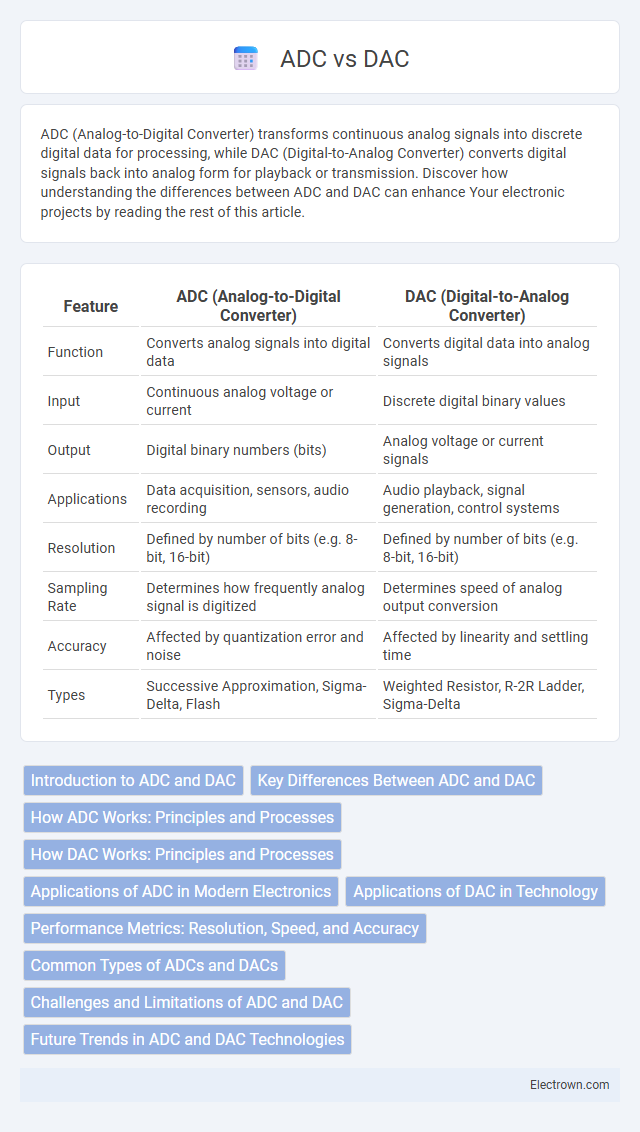ADC (Analog-to-Digital Converter) transforms continuous analog signals into discrete digital data for processing, while DAC (Digital-to-Analog Converter) converts digital signals back into analog form for playback or transmission. Discover how understanding the differences between ADC and DAC can enhance Your electronic projects by reading the rest of this article.
Table of Comparison
| Feature | ADC (Analog-to-Digital Converter) | DAC (Digital-to-Analog Converter) |
|---|---|---|
| Function | Converts analog signals into digital data | Converts digital data into analog signals |
| Input | Continuous analog voltage or current | Discrete digital binary values |
| Output | Digital binary numbers (bits) | Analog voltage or current signals |
| Applications | Data acquisition, sensors, audio recording | Audio playback, signal generation, control systems |
| Resolution | Defined by number of bits (e.g. 8-bit, 16-bit) | Defined by number of bits (e.g. 8-bit, 16-bit) |
| Sampling Rate | Determines how frequently analog signal is digitized | Determines speed of analog output conversion |
| Accuracy | Affected by quantization error and noise | Affected by linearity and settling time |
| Types | Successive Approximation, Sigma-Delta, Flash | Weighted Resistor, R-2R Ladder, Sigma-Delta |
Introduction to ADC and DAC
Analog-to-Digital Converters (ADC) transform continuous analog signals into discrete digital values, enabling microprocessors to process real-world inputs like sound or temperature. Digital-to-Analog Converters (DAC) perform the inverse function, converting digital data into analog signals for devices such as speakers or analog meters. Both ADCs and DACs are essential components in electronics, facilitating communication between analog environments and digital systems.
Key Differences Between ADC and DAC
ADC (Analog-to-Digital Converter) transforms continuous analog signals into discrete digital values, enabling digital systems to process real-world inputs. DAC (Digital-to-Analog Converter) performs the opposite function, converting digital data back into continuous analog signals for output devices like speakers or displays. Understanding the key differences in signal direction, resolution, and application helps optimize your electronic design for accurate data acquisition and faithful signal reproduction.
How ADC Works: Principles and Processes
An Analog-to-Digital Converter (ADC) works by sampling an analog signal at discrete intervals and quantizing these samples into binary values. The process involves three key stages: sampling, quantization, and encoding, where sampling captures the continuous-time signal, quantization maps the amplitude to a finite set of levels, and encoding converts these levels into a digital binary code. Accurate ADC performance depends on resolution (measured in bits) and sampling rate, which determine the fidelity and frequency range of the digitized signal.
How DAC Works: Principles and Processes
A Digital-to-Analog Converter (DAC) transforms binary digital signals into continuous analog voltages or currents using techniques like pulse-width modulation, resistor ladder networks, or sigma-delta modulation. The DAC interprets the digital input code and generates corresponding voltage levels by controlling switches and reference voltages with precision, ensuring accurate signal reconstruction. Key parameters influencing DAC performance include resolution (measured in bits), sampling rate, linearity, and signal-to-noise ratio, which collectively determine the quality of the analog output.
Applications of ADC in Modern Electronics
Analog-to-Digital Converters (ADCs) are essential in modern electronics for converting real-world analog signals into digital data, enabling processing, storage, and analysis in devices such as smartphones, medical imaging systems, and digital audio recorders. High-speed ADCs are critical in radar systems and wireless communication, providing accurate signal digitization for improved performance and reliability. Precision ADCs support industrial automation and instrumentation by delivering accurate sensor data for monitoring and control applications.
Applications of DAC in Technology
Digital-to-Analog Converters (DACs) play a crucial role in technology by transforming digital signals into analog outputs for audio devices, video equipment, and communication systems. Your smartphone, for instance, relies on DACs to convert digital audio files into sound waves that speakers can produce, enhancing media playback quality. DACs are also integral in medical imaging, instrumentation, and automotive systems, where precise analog signal generation from digital data is essential for accurate performance.
Performance Metrics: Resolution, Speed, and Accuracy
ADC and DAC performance metrics focus on resolution, speed, and accuracy, which are crucial for signal conversion quality. ADC resolution is measured in bits, defining how finely the analog signal is quantized, while DAC resolution influences the precision of the output waveform. Speed, indicated by sampling rate for ADCs and update rate for DACs, and accuracy, involving linearity and error rates, determine how faithfully your digital and analog signals represent each other during conversion.
Common Types of ADCs and DACs
Common types of ADCs include Successive Approximation Register (SAR), Sigma-Delta, Flash, and Pipeline converters, each offering different balances of speed, resolution, and complexity for various applications. DACs commonly found are Binary-Weighted, R-2R Ladder, Sigma-Delta, and Pulse Width Modulation (PWM) types, designed to accurately convert digital signals back into analog form depending on precision and speed requirements. Understanding the distinct characteristics of these ADC and DAC types helps optimize Your system's performance in audio processing, instrumentation, and communication devices.
Challenges and Limitations of ADC and DAC
Analog-to-Digital Converters (ADC) face challenges such as quantization noise, limited resolution, and sample rate constraints that can affect the accuracy and speed of digital signal processing. Digital-to-Analog Converters (DAC) encounter limitations including output signal distortion, finite resolution, and settling time which impact sound quality and signal fidelity. Understanding these constraints helps you optimize system design for improved performance in applications like audio, communications, and instrumentation.
Future Trends in ADC and DAC Technologies
Future trends in ADC and DAC technologies emphasize higher resolution, faster sampling rates, and lower power consumption to meet the demands of emerging applications such as 5G, IoT, and autonomous systems. Innovations in semiconductor processes and integration techniques enable more compact, cost-effective converters with improved accuracy and dynamic range. Your choice of ADC or DAC will increasingly depend on these advancements to achieve optimal performance in next-generation electronic devices.
ADC vs DAC Infographic

 electrown.com
electrown.com